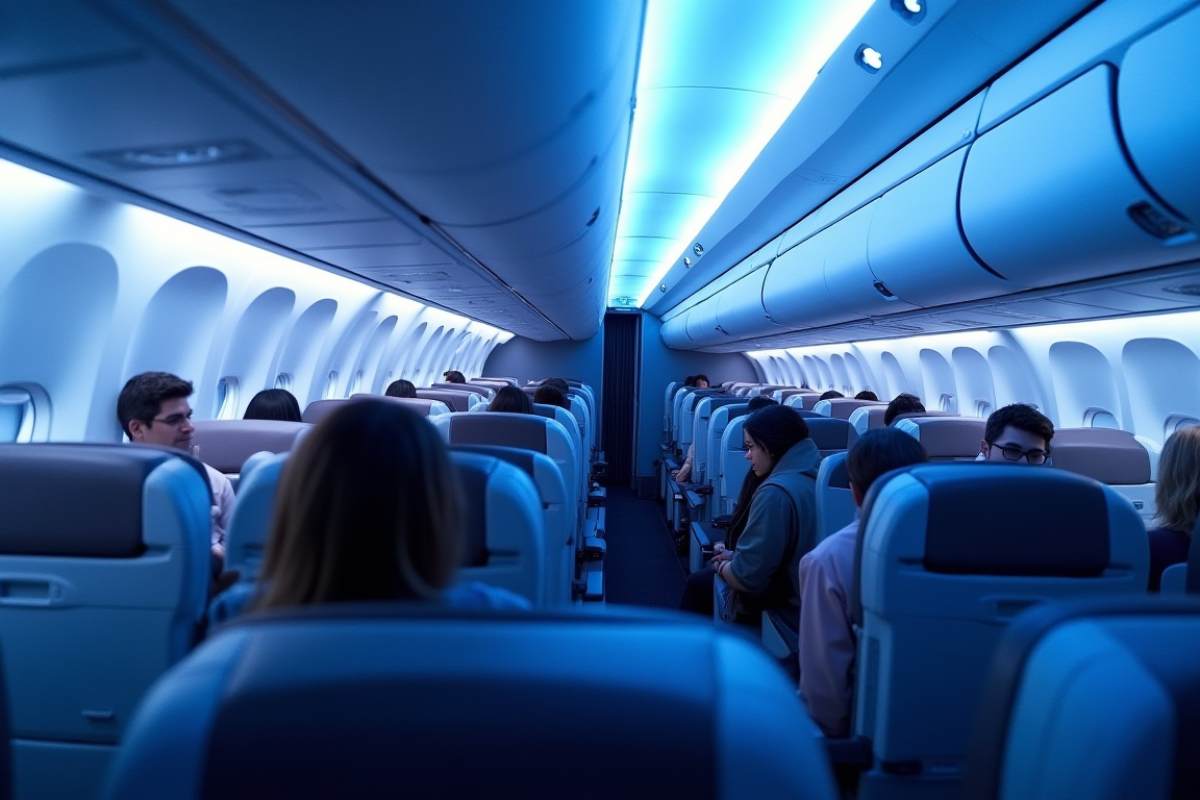JEDDAH, Step back and look up, Saudi Arabia’s aviation sector is flying at breakneck speed, and at the center of all that is Saudia, the country’s national flag carrier. The airline’s journey in the first half of 2025 isn’t just about record numbers or headline-grabbing growth. It’s a vivid window into a kingdom in transformation, where plans, policies, and people are all working overtime to bring Vision 2030 into sharp, roaring focus.
So, how did Saudia go from a respected regional airline to a global contender that industry insiders everywhere are tracking?
It started, as so many growth stories do, with ambition. But this one comes with horsepower: over 17.5 million passengers carried from January to June 2025 alone. That’s a 7.2% jump over the previous year. Not content to rest there, Saudia set its sights on more, investing in fleets, new destinations, and a relentless quest for operational excellence.
Let’s break down what’s fueling this ascent, and what lies ahead for the airline and the country it serves.
Record-Breaking Growth: By the Numbers
Here’s the headline: Saudia carried more than 17.5 million guests in the first half of 2025 alone, up 7.2% from last year.
Let’s unpack that:
- International departures were robust, with 9.6 million international guests, a 5% year-on-year increase.
- Domestic demand soared to 7.9 million passengers, a striking 10% jump compared to the prior year.
- More than 100,000 flights operated, clocking up a staggering 293,500 flight hours in just six months.
- The airline’s on-time performance (OTP)? Try 89.6%. And for not one but two separate months, March and June 2025, Saudia earned the top worldwide spot for punctuality, according to Cirium analytics data.
Funny thing is, those numbers aren’t just stats, they’re major signals. Signals of a sector not only growing in size but maturing in sophistication and reliability.
Fleet and Network Expansion
- Current fleet: 148 aircraft, one of the youngest airline fleets in the Middle East.
- Aggressively expanding: 117 new aircraft already on order, targeted for delivery over the coming years.
- As of now, the airline operates across about 100 destinations. By 2030? Saudia says they’ll be at 145 destinations, connecting Saudi Arabia to more points, more often, and with more frequency than ever.
Strategy in the Skies: How Saudia Is Expanding
Growth at this scale doesn’t come by accident, and it’s not just about buying new planes. Saudia’s recent rise is the result of a layered, intentional strategy:
Doubling Down on Guest Experience
Board a Saudia flight in 2025, and you’ll notice the difference: traditional Saudi coffee, locally inspired cuisine, cabin retrofits, high-speed Wi-Fi, and curated Saudi entertainment content all play a part. It’s a full-sensory experience designed so that, as Khaled Tash, the airline’s CMO, put it, “customers sense Saudi culture the moment they step on board.” The traditional and the futuristic, all in one cabin.
Fleet Modernization and Digital Transformation
Refurbishing the existing Boeing 777s and Airbus A330s by 2027, the airline is laser-focused on business-class comfort as well as digital connectivity. High-speed Wi-Fi (with streaming and gaming!), upgraded seat comfort, and new business-class suites are all rolling out.
Digital investments don’t stop at the passenger interface, either. Behind the scenes, the airline is enhancing planning and execution systems, using advanced analytics and digital tools to improve everything from flight planning to operational efficiency.
Expanding the Global Reach
More aircraft isn’t just about more flights. It’s about new connections. In 2025 alone, Saudia announced 11 new international destinations, with Moscow added to its schedule as part of a strategic partnership to boost year-round tourism and business. The expansion to 145 destinations by 2030 isn’t just a corporate goal. It’s a national one, dovetailing with Saudi Arabia’s Vision 2030 ambitions to welcome more visitors, pilgrims, and business travelers than ever before.
Partnerships and Alliances
Saudia’s role in major airline alliances, especially SkyTeam, opens the Kingdom to the world and makes transit easier for millions. Codeshare and interline agreements with the likes of WestJet, Delta, and Virgin Atlantic amplify this reach, letting travelers connect through Saudi hubs from points worldwide.
New Digital Visas
A quirky but critical innovation: a 96-hour transit visa that enables stopover travelers to explore Saudi Arabia, visa-free, for up to four days. Developed in partnership with Saudi authorities, this initiative is helping turn transit passengers into temporary tourists.
Powering Vision 2030: Beyond Just Airplanes
Beneath the surface, Saudia’s record growth is no isolated feat. Instead, it’s tightly interwoven with Saudi Arabia’s Vision 2030, a sweeping economic reform agenda that aims to diversify the economy away from oil and reposition the Kingdom as a global hub for trade, tourism, and innovation.
How Aviation Fits the Kingdom’s Vision
- Tourism as a Growth Engine: Projects like NEOM, the Red Sea Development, and AlUla are anchoring Saudi Arabia’s shift toward inbound tourism, planes are key to making these massive ambitions not just viable, but inevitable.
- Aviation Sector Growth: The Kingdom’s aviation industry, valued at $1.2 billion in 2023, is projected to grow at 8.88% annually from 2025 through 2029, on course to handle 330 million passengers at 250 destinations by 2030.
- Economic Impact: The sector already supports nearly a million jobs and contributes billions to the national GDP. As network links and capacity rise, so does the impact across tourism, trade, and logistics.
Infrastructure and Regulatory Reform
Saudi aviation isn’t only about big jets and fancy lounges. In 2024 and 2025, the General Authority of Civil Aviation (GACA) pushed through major regulatory reforms, streamlining airport charges, loosening restrictions on foreign charters, and establishing independent oversight to keep the industry competitive. These steps are positioning Saudi Arabia as the region’s most open, traveler-friendly aviation market.
Leadership Changes: The New Face of Saudia Cargo
At the heart of every dynamic organization are the people steering the ship, or the aircraft. On January 1, 2025, Saudia Cargo, a critical division of the Saudia Group and a key player in both the kingdom’s logistics and global supply chains, welcomed a new Chief Executive Officer: Eng. Loay Mashabi.
Who Is Eng. Loay Mashabi?
Loay Mashabi isn’t just a career airline executive; his resume paints him as a strategist deeply connected to Saudi Arabia’s logistics transformation. Before joining Saudia Cargo, he served as deputy minister for logistics services and helped pave the way for several flagship projects under Saudi Vision 2030. He succeeds Teddy Zebitz, whose tenure saw Saudia Cargo post record results and modernize its offerings. Zebitz will remain on the board, ensuring continuity during this leadership change.
“As part of his new role, Mashabi will focus on accelerating Saudia Cargo’s growth and expanding its international network, while also advancing Vision 2030’s ambitious logistics goals,” airline officials confirmed.
Redefining Saudi Aviation: The Bigger Picture
Saudia’s story, while impressive, is just one piece of a much broader aviation renaissance in Saudi Arabia.
New Players on the Horizon
- Riyadh Air: Backed by Saudi Arabia’s Public Investment Fund (PIF), this new full-service airline is set to launch before the close of 2025. Insiders call it a “watershed moment”, expected to compete with global heavyweights, while pushing up standards for the entire sector.
- Flynas and Flyadeal: The low-cost segment is equally active. Flynas, already boasting record profits, is preparing for a major IPO. Flyadeal is ramping up to serve an expanding network, supported by new aircraft orders.
Numbers That Matter
- In 2024, Saudi airports handled 128 million travelers, up 15% from the year before.
- Over 905,000 flights were recorded, an 11% increase year-on-year.
- International connectivity soared, with over 170 worldwide destinations now linked to Saudi airports.
Economic Winds
- Brent oil forecasts for 2025 have been revised sharply down to $66 per barrel, well below the fiscal break-even for the Kingdom. That means the aviation sector, with its new focus on both commercial efficiency and passenger comfort, is more important than ever for economic resilience.
- This new financial discipline, expanding through borrowings, carefully prioritizing projects, and attracting foreign capital, shows a sector and a nation focused on sustainable, measurable returns.
Challenges, Competition, and the Road Ahead
Here’s the kicker: while the numbers and headlines tell a story of momentum, challenges do remain.
Market Pressures
- Oil prices falling below target mean tighter budgets and a sharper eye on which aviation projects deliver the biggest impact.
- Ambitious plans like fleet expansions and rapid network growth require heavy capital, which the government continues to raise through debt markets (including a $1.25 billion sukuk in early 2025).
Stiff Competition
- New entries like Riyadh Air mean Saudia can’t take its leading position for granted. The market is big enough for multiple winners, but only those that keep innovating and delivering what passengers and the economy need will claim a sustainable share.
Regulatory and Workforce Hurdles
- Maintaining customer service and reliability in an industry growing this quickly is no small feat. Saudia’s focus on digital systems and upgraded training is an attempt to ensure quality keeps pace with quantity.
Key Growth Points at a Glance
- 17.5 million passengers in H1 2025, a 7.2% increase year-on-year.
- 9.6 million international and 7.9 million domestic travelers, both sharply up from 2024.
- Over 100,000 flights operated; on-time performance rate of 89.6%.
- Fleet size: 148 aircraft (among the youngest regionally), with over 117 more orders on the way.
- Global ambition: Tackling 145 destinations by 2030.
- Market standing: Top global ranking for punctuality; more alliances and partnerships than ever before.
- Financial muscle: Raising billions in new financing, even while tightening fiscal discipline.
- Vision 2030 alignment: All expansion is part of a bigger plan, opening Saudi Arabia to the world, well beyond oil.
The Human Element: Inside the Transformation
Of course, statistics only tell part of the story. What separates Saudia in 2025 is a relentless drive from its workforce, a national team behind the scenes, from operations to guest services, who have not just kept up with the pace but powered the leap. Upgraded training, stronger investment in skill-building, and a focus on hospitality are front and center.
Quotes from airline leadership consistently tie these operational successes to Saudi talent and to the national mission: “These achievements reflect the dedication and expertise of Saudia’s national workforce across all sectors, particularly in operations, planning, execution, and performance monitoring.”
From Record-Breakers to Trailblazers: What’s Next?
As Saudi Arabia approaches the halfway point of 2025, the outlook is clear: this is an era of transformation, and Saudia Airlines is not just keeping up, it’s setting the pace. The airline’s growth is a signal flare, visible to travelers, industry experts, and economic analysts alike, that the kingdom’s strategy, high investment, high ambition, and high standards, is working.
Expect more headlines as the year progresses, with new aircraft rolling off production lines, new routes launching, and a rapidly expanding ecosystem of travelers, trade, and talent orbiting the kingdom’s skies.
If the first half of 2025 is any sign, buckle up; the story of Saudia, and Saudi aviation more broadly, is only just getting started.








